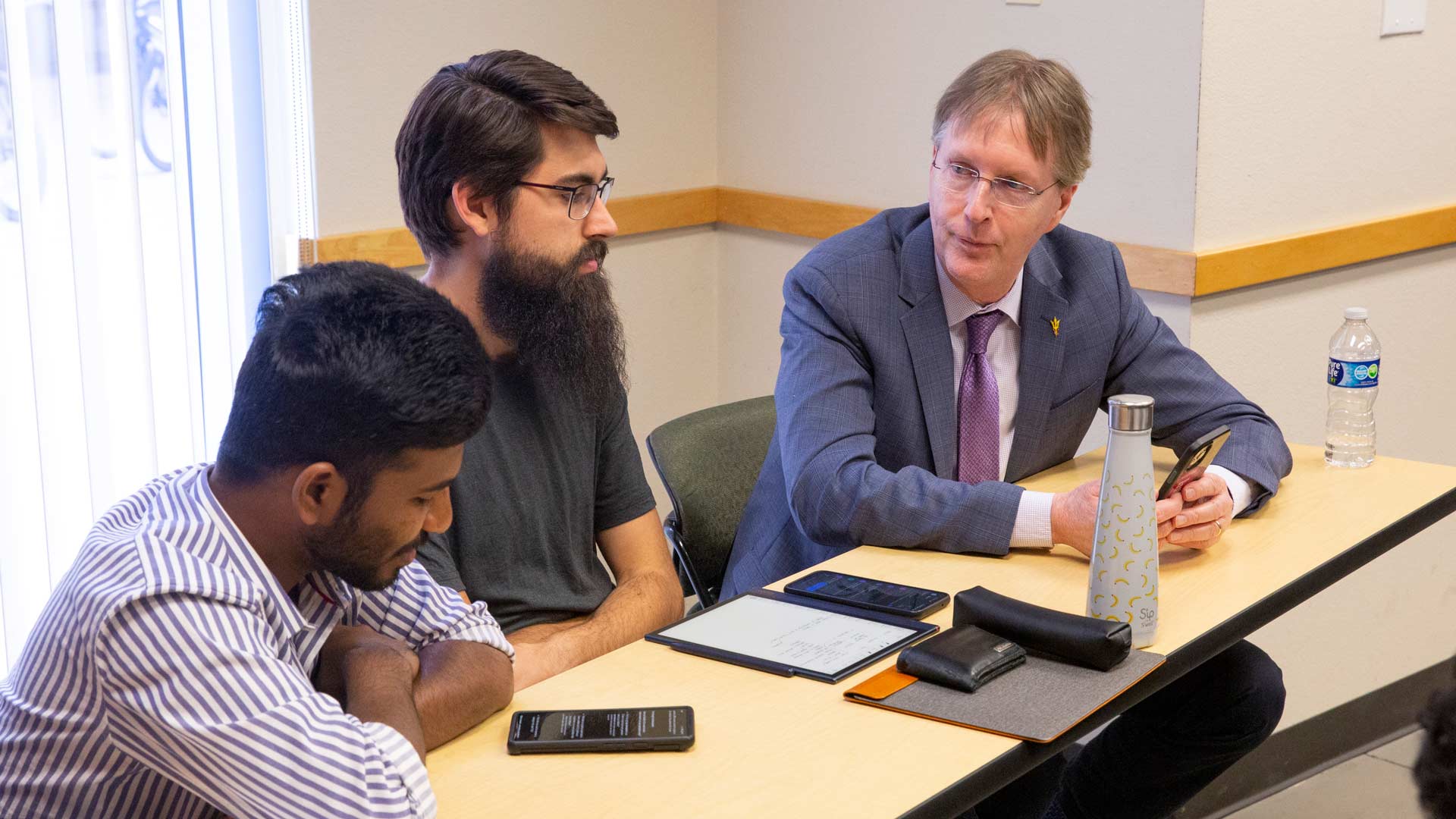
Distinguished lecture series showcases industrial engineering
The inaugural Douglas C. Montgomery Distinguished Lecture at ASU featured Harriet B. Nembhard

This month, the School of Computing and Augmented Intelligence, part of the Ira A. Fulton Schools of Engineering at Arizona State University, presented the inaugural Douglas C. Montgomery Distinguished Lecture.
Generously supported by Douglas Montgomery, an ASU Regents Professor of industrial engineering, the new lecture series serves as a forum for the exchange of current topics related to industrial engineering.
To kick off the first annual event, faculty, students and alumni joined guest lecturer Harriet B. Nembhard, dean of the College of Engineering at the University of Iowa and an ASU alumna.
A well-respected member of the industrial engineering community, Nembhard researches ways to improve complex systems in manufacturing and health care. She has held academic leadership positions at Oregon State University and Penn State, and her work has been recognized by election to the status of fellow of the American Society for Quality, Institute of Industrial and Systems Engineers and American Institute for Medical and Biological Engineering.
Nembhard is also preparing for her new role as president of Harvey Mudd College, beginning July 1, 2023.
“I think Dr. Nembhard was an outstanding choice as the inaugural lecturer for this series,” Montgomery says. “It’s like we hit a homerun.”
Kyle Squires, the ASU vice provost for engineering, computing and technology and dean of the Fulton Schools, kicked off the event, thanking Montgomery for his vision in creating the series to raise the profile of the industrial engineering program at ASU and noting that it was a great honor to introduce Nembhard.

Nembhard encouraged attendees to work together to brainstorm real-world examples of how Quality 4.0 could be implemented at Arizona State University. Photographer: Erik Wirtanen/ASU
Nembhard’s lecture focused on how higher education institutions can benefit from implementing Quality 4.0, a concept that aligns Industry 4.0 technologies — such as artificial intelligence, cyber-physical systems and big data analytics — alongside a robust skill set and competencies in critical thinking, collaboration and leadership. The end result improves the quality of an organization and the outcomes it creates.
“Quality 4.0 is something of a substrate for the way that I’ve approached leadership in many ways,” she says. “It addresses the challenges that academic leaders face from quality training to more technical challenges on the managerial side, and has influenced the way that I lead. I think it offers a lot for academic leaders to contemplate.”
She presented attendees with thought-provoking ideas, providing a basic understanding of Quality 4.0 axes and giving examples of how they can be applied to improve higher education processes.
Beyond being highly informative, her talk also offered an opportunity for discussion and creative thinking. Participants were challenged to brainstorm solutions for problems including how Quality 4.0 can improve six-year graduation rates and how to humanize education at ASU.
Nembhard says she hopes that attendees reflect on Quality 4.0 and its potential to impact higher education, noting that her goal for the talk was to encourage reflection and spark curiosity for how industrial engineering can be applied to all areas of life.
“Industrial engineering is about systems, and higher education is a system we can work to improve,” she says. “We, as industrial engineers, have the capacity to influence how rapidly improvements and advancements can happen in the academy through the way that we do strategic thinking and develop a culture of quality and collaboration.”
For Nembhard, her background as an ASU alumna made the lecture experience even more fulfilling.
“Dr. Montgomery’s work was a model for the type of applied research in alignment with industry that really mattered to me early on in my career,” Nembhard says. “To come back to where, in some sense, a lot of the work that I’ve done in my academic career had started is really special. To be asked to give the inaugural lecture is a tremendous honor.”

Kyle Squires, ASU vice provost for engineering, computing and technology and dean of the Fulton Schools, participated in the event and spoke with students during the brainstorming activity. Photographer: Erik Wirtanen/ASU
Equally as fulfilling for Nembhard was the opportunity to recognize her late mother, Helen L. Eastman, also an ASU alumna who studied English during her time at the university. Nembhard dedicated the talk to her mother’s memory.
Nembhard says she hopes those who came to her lecture will be motivated to more deeply understand the enterprise of academia and work to advance industrial engineering when envisioning the future of higher education.
Esma Gel, a Fulton Schools associate professor of industrial engineering and longtime friend of Nembhard’s, was also in attendance. The two have been friends for 25 years because of their involvement in the industrial engineering community.
“It’s wonderful to be able to see Harriet speak and be recognized for her contributions to this field,” she says. “She’s a great person, in addition to being a notable member of the industrial engineering community. So, it’s amazing to see someone like her be rewarded with these kinds of well-deserved opportunities.”
In reflecting on the inaugural lecture, Montgomery notes that his goal for the series is to increase visibility of the industrial engineering discipline, both at ASU and across the field.
“We have a really good industrial engineering program at ASU, and some really outstanding faculty with many noteworthy accomplishments,” he says. “I hope that this lectureship will be an opportunity to celebrate that and also showcase it more broadly to industrial engineering professionals.”

Harriet B. Nembhard (far right) was honored with an award recognizing her as the first featured speaker of the Douglas C. Montgomery Distinguished Lecture series. From left, she is pictured alongside Professor Ross Maciejewski, director of the School of Computing and Augmented Intelligence, Kyle Squires, Arizona State University vice provost for engineering, computing and technology and dean of the Fulton Schools, and Douglas Montgomery, an ASU Regents Professor of industrial engineering. Photographer: Erik Wirtanen/ASU



































